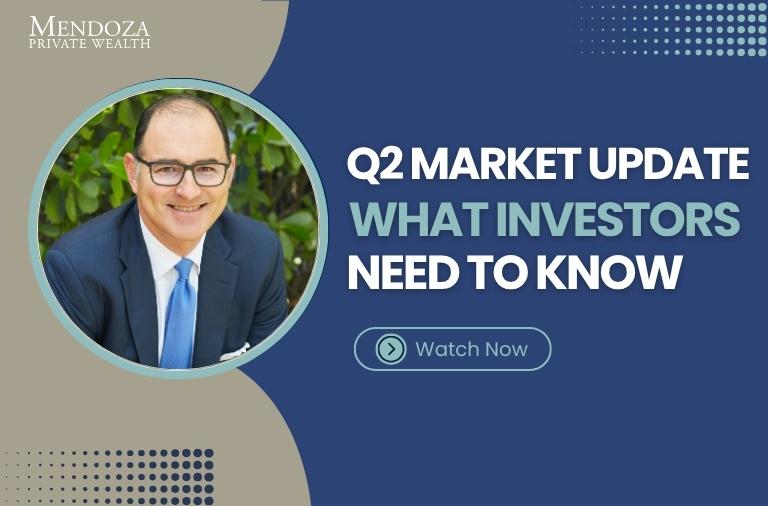The markets gave us plenty to talk about this past quarter. Between shifting tariffs, geopolitical tensions, and a strong rebound led by tech and international stocks, it was anything but boring.
I put together a short video walking through:
- What moved the markets in Q2
- How different investments held up (or didn’t)
- And why the Fed’s next steps matter for your portfolio
Take a few minutes to watch the video to gain a clear understanding of where things stand and what to keep an eye on for the remainder of the year.
And as always, if all this recent volatility has you questioning whether your portfolio is properly positioned, feel free to reach out. I’d be happy to take a look and see if you’re still on track.
Transcript
The first six months of 2025 have been anything but boring. From tariff surprises to geopolitical conflicts and shifting economic data, the first half of the year has tested investors’ nerves and strategies alike. Hi, I’m Ivan Mendoza, Managing Principal at Mendoza Private Wealth.
Key Market Insights from the First Half of the Year
In this video, I’ll review the key highlights of the first half of the year so you can understand what’s driving the market and what it means for your financial plan.
So let’s start by taking a closer look at the dynamics that led to a bounce back in equities. As you can see in this first chart, from the peak in mid-February to the bottom in early April, concerns around global tariffs caused an almost 20% correction in the S&P 500 index.
Market Stabilization Following Trade Announcements
Once the 90-day pause on tariffs was announced, investors felt reassured that there might be opportunity for further negotiations or at least more time to digest the changes. The market was further reassured when, just a few weeks later, the U.S. and U.K. announced the tentative trade deal. Talks of a tentative U.S. and China trade deal helped as well.
Stock Market and Global Performance Review
All of this has led to an S&P 500 year-to-date performance through June of 6.2%. Surprisingly, in spite of geopolitical concerns around global trade, developed non-U.S. markets like Europe, Asia, and the Far East put up an even more impressive 19% return, with emerging markets not too far behind at 15%.
In fixed income, municipal bonds were basically flat for the year, which was a bit disappointing, but perhaps even more so when compared to U.S. taxable bonds, which were up 3.8%.
But all in all, this is a solid first start to the year, although certainly there was serious volatility along the way. Going forward, inflation still remains a focal point, as the Federal Reserve weighs its next move later this month.
Inflation Trends and Federal Reserve Strategy
Fortunately, as you can see here on the far left side, both CPI, Consumer Price Index, as well as PCE, Personal Consumer Expenditures, have been steadily trending down toward the Fed’s 2% inflation goal.
Labor Market Overview and Employment Trends
In addition to inflation, the Fed is likely keeping a very close eye on the labor market. As you can see here on the far left, the labor market has essentially found its way back to a balanced equilibrium point similar to pre-pandemic levels.
Contributing to this balanced state is a relatively flat layoff rate here in purple, combined with a steadily declining hiring rate in yellow. Simply put, employers have been hiring at a slower pace, but they have not shown any significant increase in massive layoffs. While a recent uptick in continuous jobless claims may be an early sign of weakness, the U.S. unemployment rate is still hovering around normal levels of around 4.1-4.2%, although this is something that we’ll be watching very carefully.
Consumer Spending Patterns and Rate Expectations
If the labor market does weaken, it may have something to do with a recent decline in consumer spending. As you can see here in the middle chart, there shows a clear downshift in consumer spending as measured by personal consumption expenditures. This puts even more pressure on the Fed to consider lowering interest rates.
Investors are still expecting rate cuts this year and in 2026. The friction is in when the rate cuts will arrive. In summary, 2025 is expected to be a low-growth year with 0.5% real GDP, while 2026 is expected to be a bit better.
Economic Forecast for Inflation and Growth
Inflation expectations remain a bit elevated at 3.8% this year, but hopefully inflation will continue to cool down into the 2% range by year-end 2026. With this rebound, the market is essentially giving investors a bit of a gift, a second chance this year, if you will, to determine if a reduction in risk would be appropriate. In general, we recommend staying fully invested and diversified across asset classes, but we do think this is a great time to revisit the overall level of equity exposure and particularly reassess any concentrated decisions.
The Importance of Financial Planning and Advice
If all of this leaves you questioning whether your current strategy still makes sense, that’s where having a trusted advisor can really make a difference. Navigating today’s market dynamics isn’t easy, but with the right strategy, you can stay on course toward your financial goals. If recent market volatility has you wondering whether your portfolio is well-positioned, I’m here to help.
Contact Mendoza Private Wealth for a Portfolio Review
Reach out for a complimentary review of your investments and make sure that they’re aligned with your risk tolerance and long-term objectives. Contact me at 305-501-5133 to get started.


